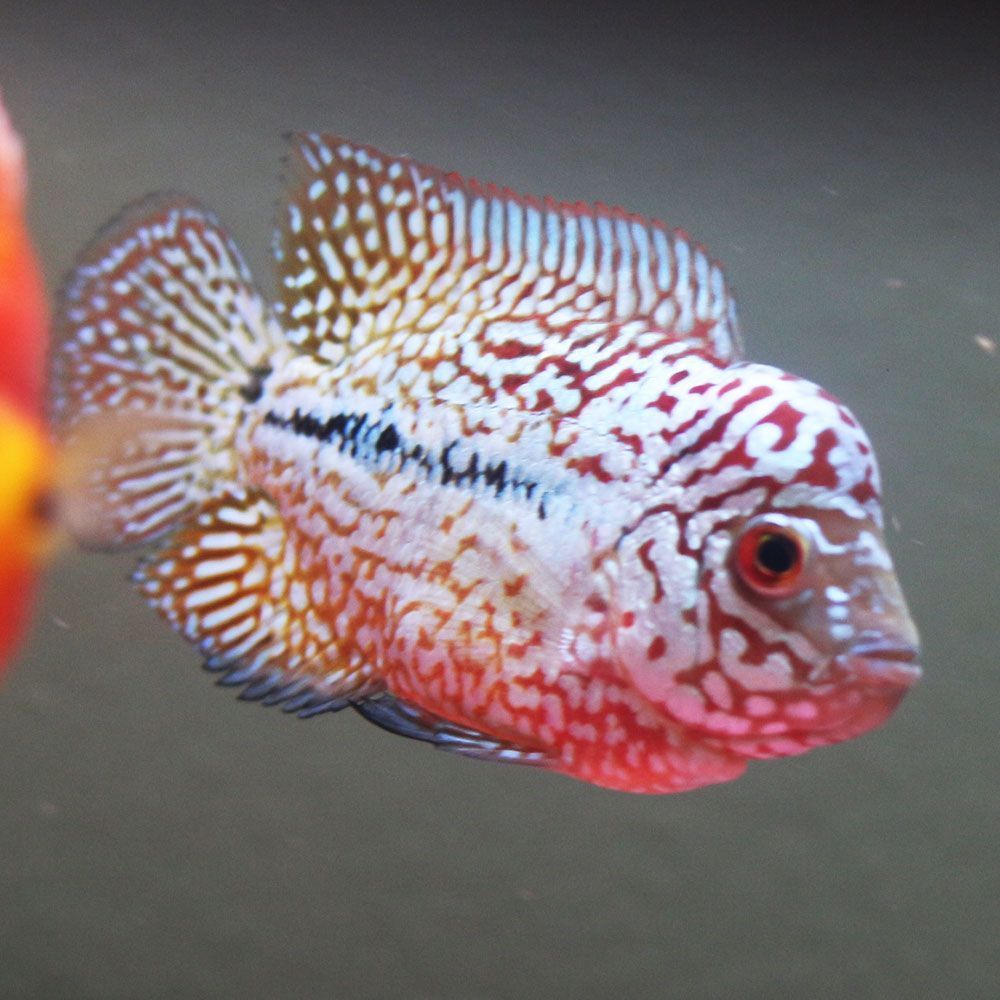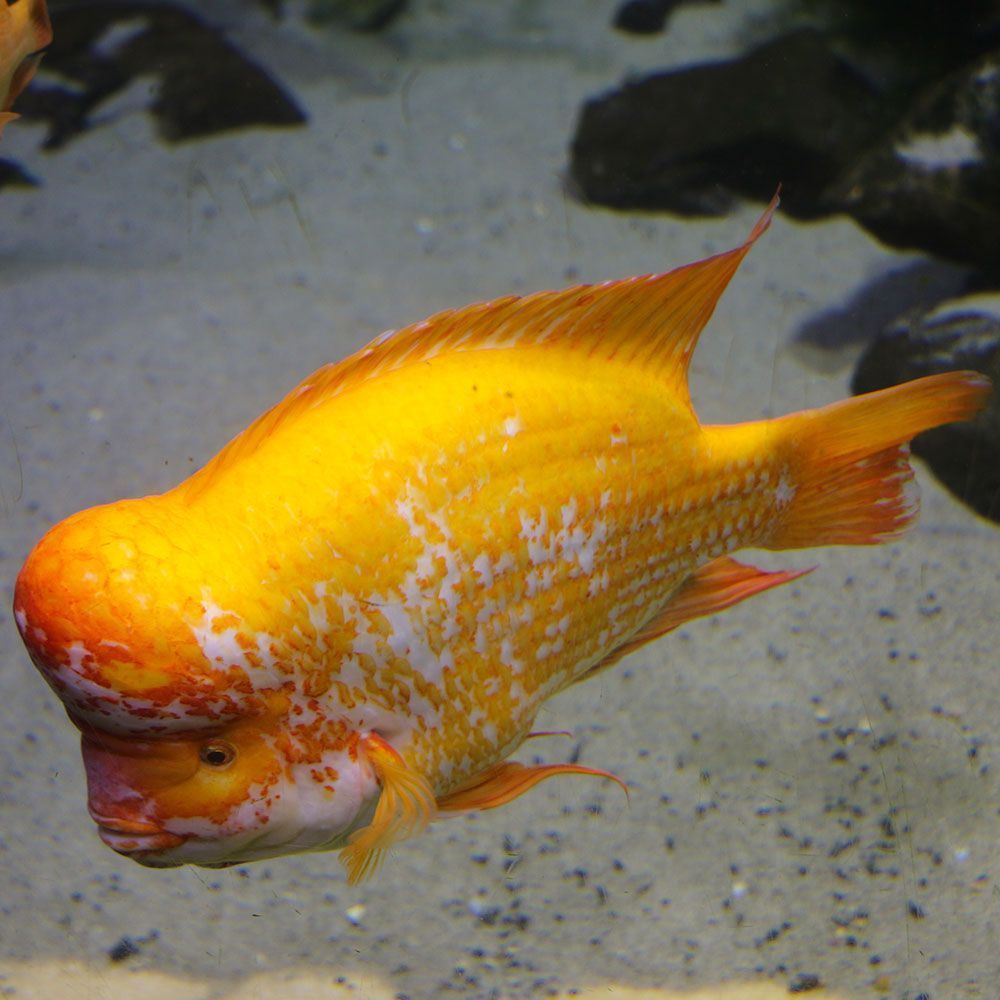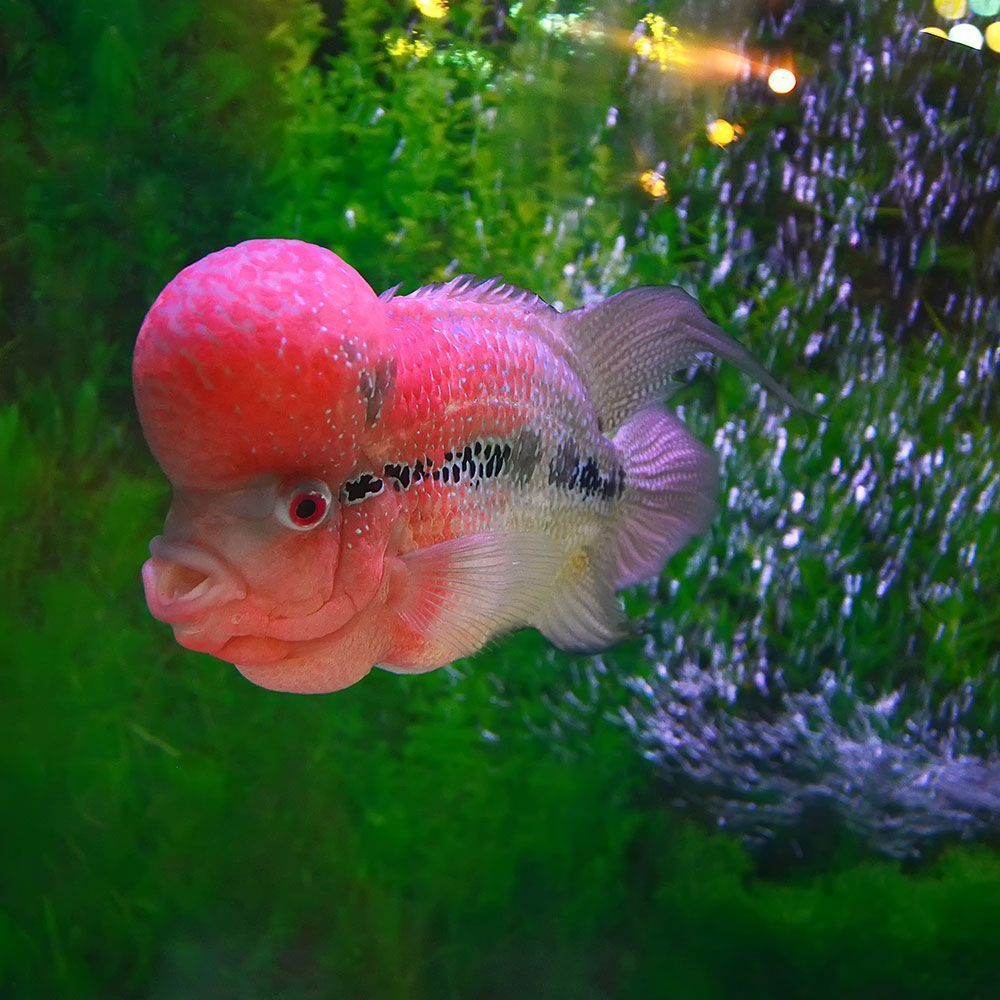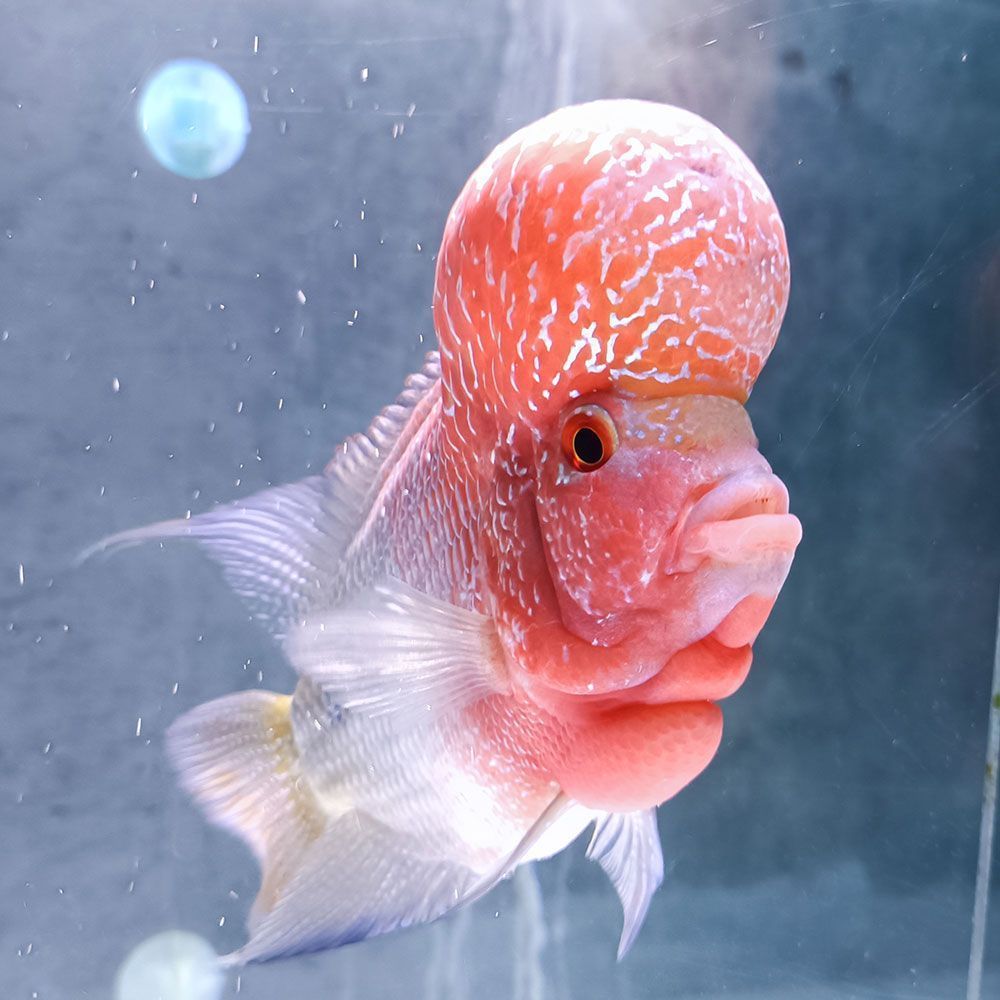The flowerhorn cichlid is a colorful and exotic freshwater species. The artificially created friendly fish can especially recognize the face of its owner/caretaker. It led to its name, “the dogs of the aquarium hobby.”
Moreover, if you have a little experience in the hobby, this fish can be pretty easy to raise. So, if you feel intrigued enough to get one, keep reading!
Fun Fact: In Asia, flowerhorn cichlids are considered a sign of luck, fortune, prosperity, and health.
What is Flowerhorn Cichlid?
Flowerhorn cichlid is a freshwater fish that belongs to the Cichlidae family of fish.
| Origin | Artificially bred: released in Malaysia, Singapore, Thailand, Taiwan |
| Order | Cichliformes |
| Family | Cichlidae |
| Scientific Name | Amphilophus (hybrid species) |
| Common Names | Flowerhorn fish, Flowerhorn cichlid |
| IUCN Red List Status | Not Evaluated |
| Appearance | Stocky colorful body, head hump with occasional flower pattern, erect tail and fins, protruding eyes |
| Size | 15-40 cm (6-16 in) |
| Lifespan | 8 to 12 years |
| Temperament | Slightly aggressive |
| Tank Level | Middle dwellers |
| Water Temperature | 75-86 °F (24-30 °C) |
| pH Level | 6.5-8.0 |
| Water Hardness | 8-20 dGH |
| Care Level | Moderately Easy |
| Minimum Tank Size | 100 gallons for one; 150 gallons for two |
| Tank Environment | Spacious, highly vegetated tank |
| Diet | Omnivore |
| Tank Mates | Other flowerhorns, equally aggressive, big, and fast-moving species |
What is the Natural Habitat of Flowerhorn Cichlid?
Flowerhorns are a result of artificial cross-breeding. So, they don’t belong to a particular natural habitat.
However, they have been released in many waterbodies in Singapore, Malaysia, Taiwan, and Thailand.
Some state that it was mistakenly released and has become an invasive pest in those areas. Moreover, it’s illegal to import the species to Australia.
Which family do Flowerhorn Cichlid belong?
Flowerhorn cichlids are not available in the wild. The species are a result of extensive interbreeding of various South American cichlids by Malaysian fishkeepers around mid 20th century.
These fishes are identified with their unique bump on the head and broad oval bodies, which set them apart from the rest.
The creation of flowerhorns was possible because cichlids can mate with any species of the opposite gender. This led to a wide range of this fish.
Flowerhorns belong to the Amphilophus genus of the Cichlidae family under the order Cichliformes.
Currently, there are 18 recognized species under this genus, yet there are uncountable unrecognized color variants.
The flowerhorns that are most available in stores are usually formed by crossing the Blood Parrot with hybrid Jingang Blood Parrot. They are called first-generation flowerhorns or Hua Luo Han Cichlids.
What are the types of Flowerhorn Cichlid?
While the entire article will throw light on all kinds of flowerhorn cichlids in general, let’s know a bit more about the most commonly found ones.
1. Kamfa

The Kamfa strain was produced around the early 2000s by crossing Blood Parrot cichlids with other 4 pure cichlids – regular flowerhorns, pearl scale flowerhorns, flowerhorns that fade, and zhen zhu golden flowerhorns.
So, Kamfa has almost all the good traits of the four.
The species has a much bigger nuchal hump, sunken white or yellow eyes, a short mouth, a brighter body, and a fan tail. It may sometimes show head flowers.
Kamfa also has a much more square-shaped body and is more aggressive than zhen zhu.
It is difficult to breed as it often has fertility issues and matures way later than others. However, this is the most desirable of all despite everything.
The Kamfa fish is mediumly priced, but the King Kamfa – a subtype of this strain – is the most expensive breed.
2. Golden Base or Fader

This flowerhorn is named “Fader” because the young fish loses colors and becomes black. But as it grows, the black again fades, leaving vibrant yellow or red color. The desirable red color was found by crossing green Texas cichlids with King Kong parrots.
This type is pronounced worthy only if it matures to a bright orange or golden color. Most people don’t pay attention to it until it’s an adult. That’s why this is one of the most affordable flowerhorns.
3. Zhen Zhu

Aka pearl flowerhorns have a large mouth, round tail, protruding red eyes, showy head flower, and have one of the best pearling patterns.
The Zhen Zhu also matures quickly, mates easily, and is easy to care for. This strain is the most available in the US and is a bit more expensive than the golden base.
Other than the above three, there are a lot more outstanding flowerhorns, like King Kamfa, Kamfa malau, Thai silk, King Kong Parrots, Red Ingots, Red mammons, and Golden Monkey (this costs a fortune, 1000US$ usually, and the highest sold at 600,000US$ during a 2009 Malaysian exhibition).
How do Flowerhorn Cichlid look?
These species have a spectacular and unique look which helps them stand out. So, let’s read about it in detail!
What is the Size of Flowerhorn Cichlid?
The smallest adult flowerhorn till now is 15 cm (6 in) long. And the largest one reported to date was 40 cm (16 in).
What is the Color of Flowerhorn Cichlid?
The species come in lots of color variants, from red, yellow, orange, gold, blue, green, and so on. They also have different red and white/black marbled patterns or patches on their bodies, fins, and head bumps.
What are the Features of Flowerhorn Cichlid?
The most prominent features of the stocky bright colored fish are their nuchal hump on the head, aka kok, prominent protruding eyes, and erect fins and tail.
Some flowerhorns also have silver-lined scales. This is called pearling in the fishkeeping hobby.
Other than the regular teeth, they also have teeth in the throat. The spiny rays on their dorsal, pectoral, pelvic, and anal fins help them defend against predator species. However, the remaining fins are soft. Flowerhorns aren’t great swimmers, either.
On their head, they have a big nostril on either side. Through the nostrils, they suck water and also identify the smell of other species.
How do male and female Flowerhorn Cichlid differ?
When the fish matures, the males grow to be larger, and the females are shorter and fuller. The bigger nuchal hump and more vibrant colors of males than females also show the difference.
However, this alone is not a reliable indicator to differentiate them sexually. After all, some males – depending on genetics – may not have bright colors or bigger stature. Moreover, the hump size may even fluctuate depending on different factors.
Another way is to check the adult fish’s vents. Females have U-shaped ovipositors, while males have V-shaped genital papilla there.
But in my experience, only professional aquarists at handling flowerhorns can identify the difference correctly.
What is the behavior of Flowerhorn Cichlid?
Flowerhorn cichlids are aggressive towards other species, i.e., they chase, fight, or even bite others.
Group maintenance is not necessary, but they feel less stressed in pairs. When small, you can also raise a small school to compensate for the aggression.
The diurnal cichlids are also known to act territorial and claim rocky areas in aquariums.
How Long can Flowerhorn Cichlid Live?
With the right amount of care, flowerhorns can live up to 8-12 years. Of course, this is widely dependent on genetics and tank water conditions.
Author’s Note: On the head hump of the fish, often there’s a flower-like mark which results in its name “flowerhorn.” However, all variants may not have this head flower mark.
How to take care of Flowerhorn Cichlid?

Now, if you’re eager to get a few of these bulky fin buddies home, let’s learn to provide the best care here!
What is the Tank Size for Flowerhorn Cichlid?
You can keep one adult flowerhorn in a 100-gallon tank. But the fish feels more comfortable when kept in a pair or group. So, opt for a 150-gallon tank for a pair.
Of course, you can fit a small group of young flowerhorns in 100 gallons, but be prepared with larger tanks because they grow pretty quickly.
Moreover, if you want to add any other kind of cichlid to the tank, invest in a 200-gallon tank.
What is the Water Chemistry for Flowerhorn Cichlid?
Next, you must be extremely careful about the water conditions because flowerhorns are artificially bred and most probably never experienced wide fluctuations in water parameters. So, strictly maintain these.
- pH Levels: 6.5-8.0
- Water Temperature: 75-86 °F (24-30 °C)
- Water Hardness: 8-20 dGH
- Ammonia: 0 ppm
- Nitrite: 0 ppm
- Nitrate: Below 20 ppm
What is the Tank Environment for Flowerhorn Cichlid?
The cichlids, due to their aggressive and curious nature, like to explore and modify their environment a lot. So, prepare to put the right things in its tank.
Is Substrate needed for Flowerhorn Cichlid?
Always use soft sand substrate in the tank because flowerhorn cichlids often play around and move the substrate. Rocks, pebbles, and gravel might have sharp edges which hurt the fish’s soft fins.
But if you want to add gravel, check that all the pieces are entirely rounded.
Are Plants needed for Flowerhorn Cichlid?
Beginner aquarists often avoid adding plants in flowerhorn cichlid tanks because they uproot them.
However, like their cichlid ancestors, these fish love greens around them. So, instead, you must put strong-rooted plants like anubias, java moss, and java ferns.
What type of Lighting is needed for Flowerhorn Cichlid?
You can use LED lights in this tank. However, set a proper schedule for the lights, i.e., only keep them on for 12-16 hours a day. Of course, you can also set your tank so that it gets direct sunlight.
What type of Décor is required for Flowerhorn Cichlid?
Add branches, bogwood, driftwood, and caves to this tank. Remember that the curious fish will often overturn a lot of things, and that’s completely natural. So, don’t strip them of their toys.
Which Filtration is needed for Flowerhorn Cichlid?
Use a strong and efficient oxygenating water filter with the capacity to clean tanks bigger than yours. This will ensure that your flowerhorn cichlids are always in the best environment.
What is the Water Flow Rate required for Flowerhorn Cichlid?
Since these cichlids aren’t good swimmers, they can’t restrict extreme water flow and get swayed with the water. So, use a slow to medium flow rate in the tank.
Caution: Never put your bare hands in the tank, or you may get bitten.
What do Flowerhorn Cichlid eat?
Since the bulky cichlids are omnivores, you can feed them a wide range of food – from flakes to live feed to frozen feed.
However, most of their dietary components are the following:
- Large cichlid pellets
- Protein-rich fish flakes
About a third of the diet must include
- Algae wafers
- Vegetable fish food
- Blanched spinach
- Lettuce
- Peas
You must also give meaty treats to maintain their colors like:
- Bloodworms
- Shrimps
- Crickets
- Dried grasshoppers
- Krill
- Nightcrawlers
- Earthworm
- Crawfish
However, don’t feed them mammals like beef hearts. You must also provide them for five minutes thrice a day. Don’t overfeed them; they might gain weight and face health issues.
What are the Tank Mates for Flowerhorn Cichlid?
This species is aggressive, so you need to be extra careful while picking their mates. Some of them can be…
- Other flowerhorns
- Suckermouth armored catfish (Sailfin pleco, Leopard pleco, or Bristlenose pleco)
- Oscar cichlids
- Jaguar cichlids
- Giant gouramis
- Spotted hoplos
- Big bichirs
- Silver arowanas
- Lowland cichlids
Which Tank Mates to Avoid for Flowerhorn Cichlid?
To prevent any mishap in your tank, avoid housing these species in the same tank
- More aggressive fish – they may hurt your cichlids
- Slow-moving fish – they will get bullied
- Much smaller species – they may get eaten
Here are some examples to get a better idea:
- Rasboras
- Danios
- Livebearers
- Tetras
- Loaches
- Bettas
- Koi
- Goldfish
- Freshwater angelfish
- Red-tailed sharks
- Iridescent sharks
- Rainbow sharks
- Bala sharks
- Shrimps
- Snails
What are the Common Diseases for Flowerhorn Cichlid?
Since the fish is a hybrid species, you can never guess its immunity to diseases. So, beware of these issues and prepare a kit for everything beforehand!
| Disease Name | Causes | Symptoms | Treatment |
|---|---|---|---|
| Ich | Protozoan Parasitic Infection | Flashing, white patching, tardiness, poor appetite | Add aquarium salts and ich medicine, raise the water temperature |
| Hexamita | Protozoan Parasitic Infection | Red feces, hemorrhage around head, poor appetite | Apply antifungal treatment ASAP |
| Columnaris | Bacterial Infection | Frayed fins, grey or white patching, tardiness, poor appetite | Enhance water quality, add antibiotics, reduce stress |
| Fin Rot | Bacterial Infection | Discolored or reddened fins, disintegrated or frayed fins, tardiness, poor appetite | Improve water quality, remove sharp objects, reduce stress |
Quick Tip: The bioload/waste production of this cichlid is pretty high. So, you must always stay on tiptoes to regularly check all parameters with reliable kits and perform water changes.
How to Breed Flowerhorn Cichlid?
Flowerhorns are mature enough to breed when they are about 8-12 months old. But breeders often wait until they are 2 years old to ensure complete maturity.
If you have more than a pair of these cichlids, choose the specimens based on which traits you want in the young fish.
However, before you try to make them breed, it is crucial to get their sex determined by an expert.
Next, you must follow these steps:
What is the Tank Preparation for Flowerhorn Cichlid?
Prepare a 150-gallon tank and place a glass divider in the middle. Maintain the same water conditions as usual and add flat rocks for egg laying in the substrate.
In this tank, you can increase the temperature by a few degrees more than the main tank. Avoid adding any kind of substrate.
What type of Fish Conditioning is required for Flowerhorn Cichlid?
Place the male and female fish on either side and feed them live bloodworms and other protein-rich diets. Add an antifungal solution to the water to avoid any disease due to so much live food.
What is the Mating process of Flowerhorn Cichlid?
Remove the divider and let the cichlids take over. If there’s any sign of aggression or stress between the pair, put the partition back in.
If they feel ready to mate, the female will groom a flat rock. The male fish follows after and woos her.She then lays up to 1000 eggs on the rock, and he fertilizes the eggs.
What is the Incubation period for Flowerhorn Cichlid?
During this phase, you may remove the female parent. But the male fish will protect and nurture the eggs, so don’t remove him.
After an incubation phase of three days, the eggs hatch. After another 2-3 days, you must also remove the male parent to prevent the fry from getting eaten.
Ho do Flowerhorn Cichlid Fry Develop?
Feed the free swimming fry baby brine shrimp 10 times a day. Upgrade to flake food, tubifex, daphnia, and pellets when the fry grows to 2 inches long. This is usually at 3-4 months of age.
Once the young fish is 6-8 months old, rehouse them to bigger tanks of appropriate size.
Brace yourself for disappointment because sometimes:
- Even perfectly healthy specimens may not give viable offsprings
- Pairs don’t mate even after getting the perfect conditions
- These cichlids may often be infertile due to excessive hybridization
How to Buy Flowerhorn Cichlid?
Before buying flowerhorn cichlids, always check for the seller’s authorization to avoid getting poor specimens. Whether you buy it online or offline, look up reviews about the experience of previous flowerhorn buyers.
A word from FishInAquarium
Flowerhorn cichlids add a hint of elegance and oomph to your aquarium. And, of course, the fact that this is artificially bred makes it all the more intimidating.
With that, if you feel this article made you confident to get a few, don’t forget to share it with your aquarist friends. Or if you still have doubts about housing this species, drop us a mail, and we’ll clarify everything!


